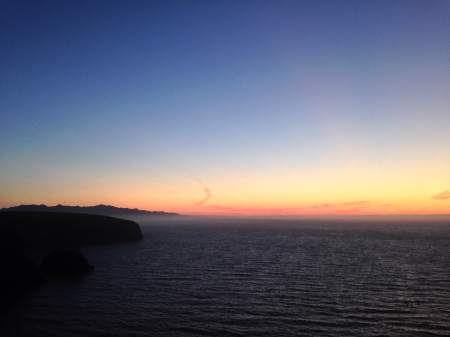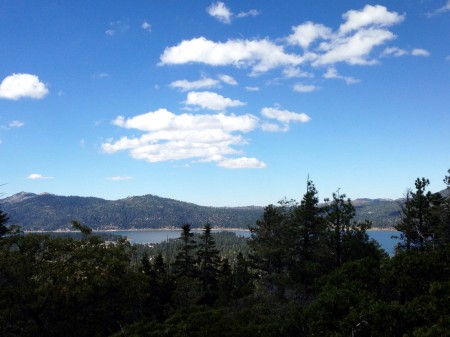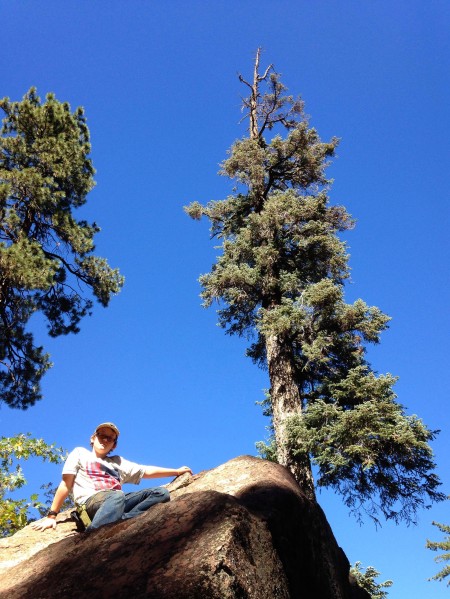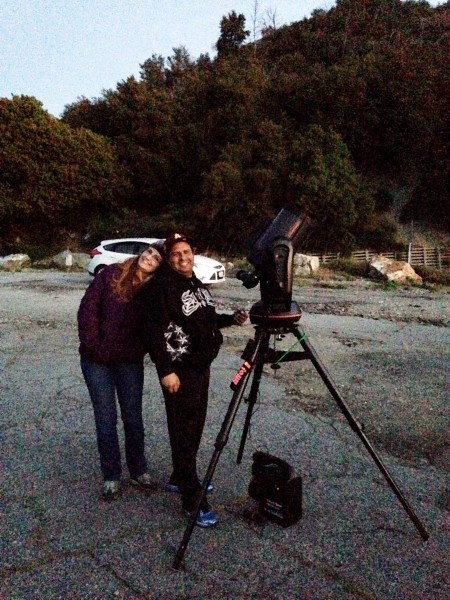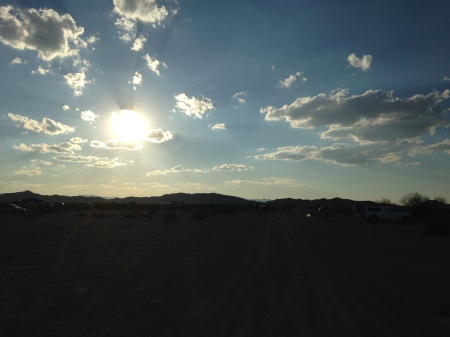In the recent post on my new NexStar 8SE, I promised to explain why I was moving quickly trying to get the scope and the mount checked out. It’s because I knew I was bound for darker skies.
This is Black Mesa, at the extreme northwestern corner of the Oklahoma panhandle. The mesa is named for the thick cap of black basalt, the product of sporadic volcanism in northeastern New Mexico over the last 20 million years or so. The basalt is capping a sequence of sedimentary rocks in which portions of the entire Mesozoic are represented, including Cretaceous sandstones, Late Jurassic limestones, clays, and mudstones, Early Jurassic aeolian sands, and Triassic sands, shales, and muds. That’s what normally takes me to Black Mesa: digging dinosaurs.
The extant vertebrates aren’t bad, either. I took this photo on my very first visit out there, in 2016. I’ve been back to dig almost every year since.
Black Mesa draws visitors for another reason: inky-dark skies. On this light pollution map, I’ve highlighted Utah and Oklahoma in white, and circled the field areas of my digs in pink. It’s not just paleontologists that are drawn to such remote areas. The Okie-Tex Star Party is held each year just outside the tiny town of Kenton, less than five miles from our dinosaur quarry.
I’ve been wanting to go to Okie-Tex for ages, but every year before this one I was too busy teaching at this time of year. This year my schedule would have allowed me to attend, but of course the star party was cancelled because of the damned pandemic (correctly, I might add). I had planned to meet up at Okie-Tex with my friend Reggie Whitten, one of the founders of the Whitten-Newman Foundation that supports our dinosaur dig out there. The WNF has a cabin near Black Mesa, and when Reggie heard that Okie-Tex was cancelled, he said to me, “Hell, Matt, come on out and we’ll have our own star party”. I knew this was coming from a couple of months out, and that’s why I was scrambling to get the new NexStar 8SE up and running: I wanted it to be my star party scope.
I started the drive out two Wednesdays ago, on September 16. It’s 1070 miles from my driveway to Black Mesa. The first day, I made it as far as Santa Fe, New Mexico. At home, I’d been stuck under groady, smoky, ashy skies since the Mount Baldy run at the start of the month, and even though I’d been on the road for 12 hours, I was craving starlight. So I drove out west of town, past the airport, found a deserted dirt road, and spent half an hour cruising around the sky with the SkyScanner 100, shown above, and 7×50 binoculars. The skies weren’t crazy dark–the light dome from Santa Fe reacted with the humidity in the air to wipe out everything from the nose of Pegasus to Cassiopeia–but I still had fun looking south and west. I caught Jupiter, Saturn, M11, M57, M56, Albireo, Alpha Vulpeculae, Brocchi’s Coathanger, M71, M27, the heart asterism around Sadr, M29, and M39. I hit the gas giants again at the end of the session, checked in on Mars, and called it a night.
The next day I mostly counted pronghorn while I drove. I love these goofy critters, and there are a lot of them in northeastern New Mexico. Between Santa Fe and the Oklahoma border I counted at least 110, in 17 groups. Not many people know that pronghorn are so ridiculously fast–60 to 65 mph–because they evolved to outrun the now-extinct American cheetah, Miracinonyx, which was probably not a true cheetah but a convergently-evolved offshoot of the North American mountain lion or cougar. Pronghorn are not only fast, they also have a preternatural ability to tell when I’m about to take a picture, at which point they bolt. So I have a lot of photos, like the one above, that show pronghorn butts as they run away.
I got in Thursday afternoon and started unpacking scopes. I’d brought four: the NexStar 8SE as my main ride and big gun, at least for this trip; the C80ED as the next-nicest backup scope in case conditions were too windy for the big C8 (that would be prophetic); the Bresser AR102S for rich-field observing; and the SkyScanner 100 because I wanted a reflector along so I could demonstrate the three main types of telescopes, and because why the heck not.
That first night was the best. It got cool, down in the 50s, but there was no appreciable wind, and the seeing and transparency were both phenomenal. On the planets and bright deep sky objects like the Ring Nebula, I just kept throwing shorter eyepieces into the C8 until I hit the 5mm MWA, which is currently my shortest decent non-Barlowed EP. I only realized the next day that the 5mm was giving 406x in the 2032mm C8, which is a heck of a lot of magnification. Here in SoCal I find there are only a handful of nights each year that I can go past about 350x–and, frankly, for the stuff I observe I rarely need any more juice than that.
The next day, conditions took a turn for the worse. First, there was wind, which is normal for Black Mesa, we’d just gotten lucky the night before. My first solution was to roll with the C80ED instead of the NexStar, but the wind was so strong that even that small, solid scope on a very competent mount was bouncing around like crazy at anything over the very lowest magnifications. The next night, I had the better idea to repark the truck perpendicular to the wind, and put the NexStar in its lee, and that worked great.
The less welcome development was the arrival of, yep, smoke from wildfires. Here’s a shot of Black Mesa looking northwest from Robber’s Roost, scaled down a bit but otherwise unretouched–compare to the photo on a cloudy day at the top of this post, which was taken from essentially the same spot. I felt a little deflated to have crossed about a third of the US for exactly one clear night. This smoke was from fires in southern Colorado, and fortunately conditions got better quickly. We had one bad night of smoke, and then things got clearer every subsequent night.
For the entirety of my stay, I was the sole astronomer in a small and ever-changing group of civilians. Almost every time out, there was at least one person who hadn’t been with us the previous evening, and consequently I spent a lot of time showing people the best and brightest objects: the Ring, the Dumbbell, M13, the Double Cluster, Andromeda, and so on. And of course, Jupiter and Saturn and Mars. Not that I’m complaining! Those crowd-pleasing objects look good from home in small scopes. Under Bortle 1 skies with 8 inches of aperture, they looked phenomenal, and I would have spent most of my time observing them even if I’d been completely alone. The Double Cluster just fits in the field of a view of a 32mm Plossl or 24mm ES 68. You could spend a long time gazing into the depths of those two clusters, and many of my companions did. Different people had different favorites: the Double Cluster, the Ring Nebula, Andromeda, but the winner for most was Saturn. Which is entirely reasonable–even after all these years of stargazing, it’s a kick in the brainpan. Every single time I look at Saturn through a telescope, I am forcibly confronted with the reality that while I’ve been dealing with meetings and oil changes and dentist appointments and grocery shopping, it’s been out there for billions of years, vast, majestic, and serene, supremely untroubled by all the traffic jams and mass extinctions and whatnot transpiring on this wee little rock far across the solar system.
One morning I got up at 4:00 to go on dawn patrol. Several folks had indicated that they might join me, but the only one who actually did was Rachelle Whitten-Newman, Reggie’s spouse. We spent an hour and a half rocking through Orion, Taurus, Monoceros, Gemini, and Auriga. The Orion Nebula looked about as good as I’ve ever seen it, and M37 looked like diamonds on black velvet.
Allow me to impress upon you just how darned dark it is out there. In the whole valley between Kenton and Black Mesa, there are about two porchlights on at night. The headlights of a car coming over the local horizon, 3 or 4 miles away–which does not happen very often–look like spotlights. The closest towns are Boise City, Oklahoma, population about 1200, which is 38 miles east, and Clayton, New Mexico, population about 2900, 45 miles to the southwest. You could draw a circle with a radius of 50 miles around Black Mesa and probably sweep up fewer than 6000 souls (the same circle around my house in Claremont would get 10 or 15 million). There are no light domes on the horizon. The major sources of light pollution are the planets themselves.
One night after packing away the telescopes I was sitting on a folding chair outside my tent, just taking in the night sky, when I realized that the entire landscape was very dimly illuminated. I can hardly stress enough how faint was this illumination–it was to the light of a bright moon what moonlight is to sunlight–but it was enough to cast pools of jet-black shadow under the cedars, the vehicles, and the awnings of the tents and buildings. I looked up to see the source of the light and the only possible culprit was Mars, soaring high overhead in the middle of the night. That’s right: out there, Mars casts shadows.
The NexStar 8SE performed like a champ. I started every evening with a 2-star align, usually on Mirfak (Alpha Persei) and Nunki–the latter is the star in the handle of the Sagittarius teapot that is closest to Jupiter. After that, the scope was good to point all over the sky, and to track for longer than I ever needed it to. I felt a little spoiled. One night I was out by myself for a bit so I decided to rock through the Messiers in the western sky. Scorpius was getting low, but I caught all of the M-objects in the “steam from the teapot” in Sagittarius and Scutum, as well as all of the globular clusters in Ophiuchus and Hercules, in about half an hour. After spending 13 years finding objects myself, and nudging the scope along, it felt a little like cheating, but I also realized that I’d never done a careful comparison between, say, M10 and M92, because I’d never gotten to observe them within 30 seconds of each other. That’s an epiphany I would never have had if I’d never used a GoTo scope. So I am looking forward to exploring the full ramifications of how this new tool will affect my observing.
Oh! I almost forgot to mention the Talentcell battery pack. MAN this thing just keeps going. I charged it to full on the day that it came in. Here’s what it’s been up to since then:
- Sept. 9: 4.75 hours of tracking, in the garage, down to 4 out of 5 charge indicator lights by the end
- Sept. 17: 3 hours of slewing and tracking
- Sept. 19: 1.5 hours of slewing and tracking, down to 3 out of 5 charge indicator lights by the end
- Sept. 20: 1.5 hours of slewing and tracking
- Sept. 21: 3 hours of slewing and tracking, still showing 3 out of 5 charge indicator lights
I haven’t had a chance to run it since I got home, but so far it looks like it will run the scope for 4-5 hours per charge light, so possibly 20-25 hours of scope operation on a single charge. Very, very happy with this thing. Now that I know that it works and the mount works, I need to velcro them together so I can stop moving the battery pack around on the eyepiece rack while the telescope is slewing, to keep the scope from unplugging itself. Here’s that model again if you’re wanting one (link). I couldn’t be happier with mine.

Yes, that’s the Bresser Messier AR102S riding on the table-top mount from the SkyScanner 100, which is itself riding on the Bogen-Manfrotto tripod. Believe it or not, at that moment that was the most capable rig I could assemble in a hurry!
All too soon, my time in Oklahoma was over. I saw even more pronghorn on the way home, at least 119 in 14 groups between Black Mesa and Santa Fe. At one point, while checking out a group of four that resolutely refused to run away, I set up a scope, and got my best-yet photo of one of these beautiful and bizarre creatures:
I’ve seen a lot more deer than pronghorn over the years, more often, and usually up closer, and I’m always struck by how different pronghorn look from deer. Their bodies are more compact and their legs even skinnier, like furry bullets on sticks. You can tell at a glance that they are built for a completely different level of speed. Marvelous animals. Long may they reign.
Later that day I made an ugly discovery, after sunset when I was barreling down I-40 west of Flagstaff: smoke from the California wildfires. It made a distinct layer in the air, visible from many miles away, as you can see in the above photo. As I-40 plunges off the western edge of the Mogollon Plateau it was like submerging in gunk. Up top, I’d been able to see for dozens of miles; I first saw the San Francisco Peaks rearing above Flagstaff before I even got to Winslow, Arizona, 60 miles to the east. When I came down into the low desert, visibility shrank to just a few miles, and I realized that the smoky air was lapping at the edges of the high country like water at a rocky shore. Yuck.
As it turns out, my astronomical adventure was not quite over. I made it as far as Kingman, Arizona, before I decided to call it and find a place to spend the night. I pulled into the Maverick station off Andy Devine Blvd, just north of I-40, and got a wrap and some yogurt for a late dinner. I walked around as I ate, to stretch my legs, and I discovered a big empty lot south and east of the store, crisscrossed with tire tracks. The moon was out, and at first quarter it looked like it had been chopped in half with a katana. I drove the truck out onto the dirt, set up the Bresser AR102S on the hood, and had a look at the moon, Jupiter, and Saturn. I didn’t spend long, only 15 minutes or so, but it was a nice coda to the trip.
What now? I’m back in SoCal, patiently waiting for the wildfires to subside, for the air to clear, and for it to get cool enough for London and I to go camping. I’m going to really enjoy having an 8-inch scope that doesn’t take up the entire back of the truck or require me to move 30-50 pounds at once. I’m going to enjoy having a scope that will track objects so I can sketch them. Who knows, I might actually get back to the Herschel 400.
And I’m going to miss Oklahoma. We had a pretty darned good run out there, despite the wind and the smoke. Reggie and Rachelle and company are already talking about turning our private star party into a yearly event, and I’m all for it. Many thanks to the two of them, to Jeff Hargrave, to Diane, Becky, James, Melissa, and Robert Newman, and to Noah Roberts for a fantastic visit. Clear skies, y’all, and keep looking up.

























